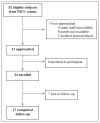Neurodevelopmental Disorders in the PICU Population
- PMID: 29096537
- PMCID: PMC7234832
- DOI: 10.1177/0009922817737080
Neurodevelopmental Disorders in the PICU Population
Abstract
Attention deficit hyperactivity disorder (ADHD), affecting 11% of children and adolescents, increases risk for injury and may predispose children to illness. However, the prevalence of ADHD and other developmental disorders in the pediatric intensive care unit (PICU) has not been previously studied. We performed a single-center, prospective cohort study of children aged 6 to 12 years who were hospitalized in the PICU from May through August 2016. Parents described their child's educational and neurodevelopmental history, and completed ADHD and emotional/behavioral disorder screening on enrollment and 1 month after discharge. Twenty-four children were enrolled. Ten patients (42%) had a prior neurodevelopmental diagnosis, and 7 (29%) met study criteria for ADHD. Children hospitalized for critical illness have a high prevalence of neurodevelopmental disabilities and are more susceptible to the impact of critical illness on development and behavior. More research is needed to better understand how to support this vulnerable population after critical illness.
Keywords: ADHD; PICU follow-up; behavioral disorders; developmental disorders; pediatric critical illness.
Conflict of interest statement
The author(s) declared no potential conflicts of interest with respect to the research, authorship, and/or publication of this article.
References
-
- Feldman HM, Ploof DL, Hofkosh D, Goehring EL., Jr Developmental needs of infants and toddlers who require lengthy hospitalization. Am J Dis Child. 1993;147:211–215. - PubMed
-
- Petersen MC, Kube DA, Whitaker TM, Graff JC, Palmer FB. Prevalence of developmental and behavioral disorders in a pediatric hospital. Pediatrics. 2009;123:e490–e495. - PubMed
-
- Boyle CA, Boulet S, Schieve LA, et al. Trends in the prevalence of developmental disabilities in US children, 1997–2008. Pediatrics. 2011;127:1034–1042. - PubMed
-
- Ertan C, Özcan ÖÖ, Pepele MS. Paediatric trauma patients and attention deficit hyperactivity disorder: correlation and significance. Emerg Medicine J. 2012;29:911–914. - PubMed
Publication types
MeSH terms
Grants and funding
LinkOut - more resources
Full Text Sources
Other Literature Sources
Medical
Miscellaneous


